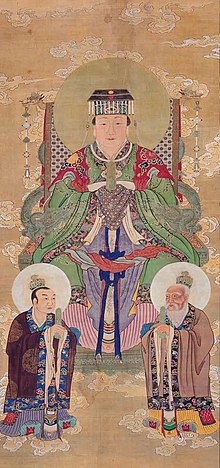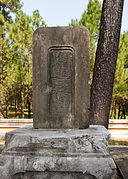Houtu: Difference between revisions
Tags: Mobile edit Mobile web edit Advanced mobile edit |
→In Daoism: removed italics and added tags to Chinese-language text |
||
| Line 33: | Line 33: | ||
===In Daoism=== |
===In Daoism=== |
||
In Daoism, Houtu is one of the [[Four heavenly ministers]], along with [[Jade Emperor]], [[Tianhuang Emperor|Gouchen Emperor]] and [[Ziwei Emperor]]. In some daoism scripts, another two gods, [[Old Man of the South Pole|Changsheng Emperor]] and Qinghua Emperor |
In Daoism, Houtu is one of the [[Four heavenly ministers]], along with [[Jade Emperor]], [[Tianhuang Emperor|Gouchen Emperor]] and [[Ziwei Emperor]]. In some daoism scripts, another two gods, [[Old Man of the South Pole|Changsheng Emperor]] and Qinghua Emperor ({{lang|zh|青华大帝}}) are added to constitute "Six heavenly ministers" ({{lang|zh|六御}}) The [[Bodhimaṇḍa|Daochang]] of Houtu is at [[Mount Jiuhua]].<ref>{{cite book |last1=张 |first1=持真 |title=忏法大观 - 维基文库,自由的图书馆 |location=Qing Dynasty |url=https://zh.wikisource.org/zh-hans/%E6%87%BA%E6%B3%95%E5%A4%A7%E8%A7%80 |language=zh-Hans}}</ref> |
||
Due to the belief that [[Tian]] (sky) represents [[Yin and yang|yang]] and [[Di (Chinese concept)|Di]] (earth) represents [[Yin and yang|yin]], most people believe Houtu is a female deity. |
Due to the belief that [[Tian]] (sky) represents [[Yin and yang|yang]] and [[Di (Chinese concept)|Di]] (earth) represents [[Yin and yang|yin]], most people believe Houtu is a female deity. |
||
Revision as of 21:19, 24 May 2023
| Houtu | |||||||
|---|---|---|---|---|---|---|---|
 | |||||||
| Chinese name | |||||||
| Chinese | 后土 | ||||||
| Literal meaning | Queen of the Earth | ||||||
| |||||||
| Japanese name | |||||||
| Kanji | 后土 | ||||||
| Kana | こうど | ||||||
| |||||||
| Part of a series on |
| Taoism |
|---|
 |
Hòutǔ (Chinese: 后土; lit. 'Queen of the Earth') or Hòutǔshén (后土神; 'Goddess Queen of the Earth'), also Hòutǔ Niángniáng (in Chinese either 厚土娘娘; 'Deep Earth Lady' or 后土娘娘; 'Earth Queen Lady'), otherwise called Dimǔ (地母; 'Mother Earth') or Dimǔ Niángniáng (地母娘娘; 'Lady Mother Earth'), is the deity of all land and earth in Chinese religion and mythology.[1] Houtu is the overlord of all the Tudigongs ("Lord of Local Land"), Sheji ("the State"), Shan Shen ("God of Mountains"), City Gods ("God of Local City"), and landlord gods world wide.
In Taoism, Houtu is one the four Four heavenly ministers, which are four of the highest ranking gods in Taoism.
Role
Houtu was originally the god of all land and earth in early chinese mythology, before being absorbed into Daoism to be one of the Four heavenly ministers.
In early mythology
According to early chinese classic Zuo Zhuan (late 4th century BC), Book of Rites and Classic of Mountains and Seas, Houtu is the son of Gonggong, being able to control the flood by installing mountains of earth.[2][3][4] He is also the assistant god to one of the Great Five Emperors, the Huang Di, being the god of the Earth element in Wuxing system. [5][6]
In early myths Gonggong also was related to the first Tudigong, his son Gou Long who was appointed as a god of the soil by Zhuanxu.[7]
In Daoism
In Daoism, Houtu is one of the Four heavenly ministers, along with Jade Emperor, Gouchen Emperor and Ziwei Emperor. In some daoism scripts, another two gods, Changsheng Emperor and Qinghua Emperor (青华大帝) are added to constitute "Six heavenly ministers" (六御) The Daochang of Houtu is at Mount Jiuhua.[8]
Due to the belief that Tian (sky) represents yang and Di (earth) represents yin, most people believe Houtu is a female deity.
In Buddhism
Some scholars link Houtu to the Buddhist goddess Bhumi, which is the personification of Earth. [9]
Worship
Houtu was first worshipped by Emperor Wen of Han (in Fenyin County, modern-day Wanrong County, Shanxi).[10] Houtu was worshiped by Emperor Wu of Han in 113 BC.[11]
Yellow River Map
Houtu is featured in some versions of the myth of the Great Flood of China: Yu did not do such a great job of channeling the Yellow River into the sea, dredging the wrong way. Sacred Mother Houtu then made the Yellow River Map and sent one of her divine messenger birds to tell Yu what to do; specifically, that he should open a channel to the east, to allow the right drainage.[12]
Gallery
Notes
- ^ Yang, 135
- ^ (”共工氏有子曰句龙,为后土。”) 《左传·昭公二十九年》
- ^ (“共工氏之霸九州也,其子曰后土,能平九土,故祀以为社。”) 《礼记·祭法》
- ^ (“共工生后土,后土生噎鸣,噎鸣生岁十有二。”) 《山海经》〈海内经〉
- ^ (”中央土,其帝黄帝,其神后土。此黄精之君,土官之臣。后土,亦颛顼氏之子,曰犁,兼为土官。”) 《礼记·月令》
- ^ (”中央,土也,其帝黄帝,其佐后土,执绳而制四方。其神为镇星,其兽黄龙,其音宫,其日戊己。”) 《淮南子·天文训》
- ^ Theobald, Ulrich. "Sheshen 社神, Local Deities (www.chinaknowledge.de)". www.chinaknowledge.de. Retrieved 2023-04-01.
- ^ 张, 持真. 忏法大观 - 维基文库,自由的图书馆 (in Simplified Chinese). Qing Dynasty.
- ^ Shaw, Miranda Eberle (2006). Buddhist Goddesses of India. Princeton University Press. p. 237. ISBN 978-0-691-12758-3.
- ^ 中国文化科目认证指南. 华语教学出版社. Sinolingua. 2010. p. 63. ISBN 978-7-80200-985-1.
- ^ "Hou Tu - MSN Encarta". MSN Encarta. MSN. Archived from the original on 29 August 2009. Retrieved 10 November 2008.
- ^ Yang, 137
Works cited
- Yang, Lihui, et al. (2005). Handbook of Chinese Mythology. New York: Oxford University Press. ISBN 978-0-19-533263-6
Further reading
- Morgan, Carole (1996). "Traces of Houtu's Cult in Hong Kong" (PDF). Journal of the Royal Asiatic Society Hong Kong Branch. 36: 223–225. ISSN 1991-7295.
See also
- Huangtian Shangdi (皇天上帝)
- Huangtian Dadi (皇天大帝)
- Tian (天) and Di (地)
- Tu Di Gong (土地公)
- Sheji (社稷)
- Chinese spiritual world concepts




